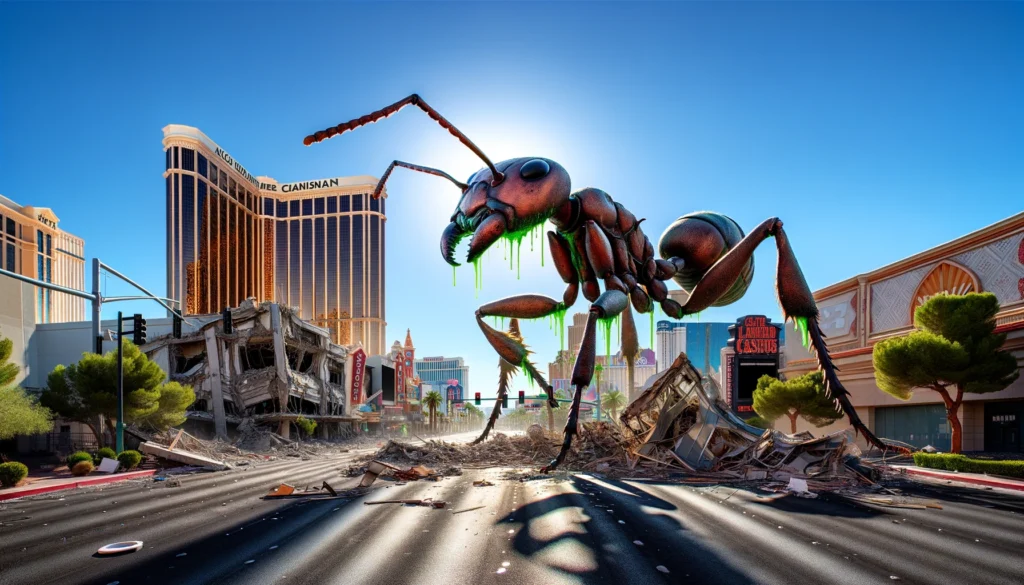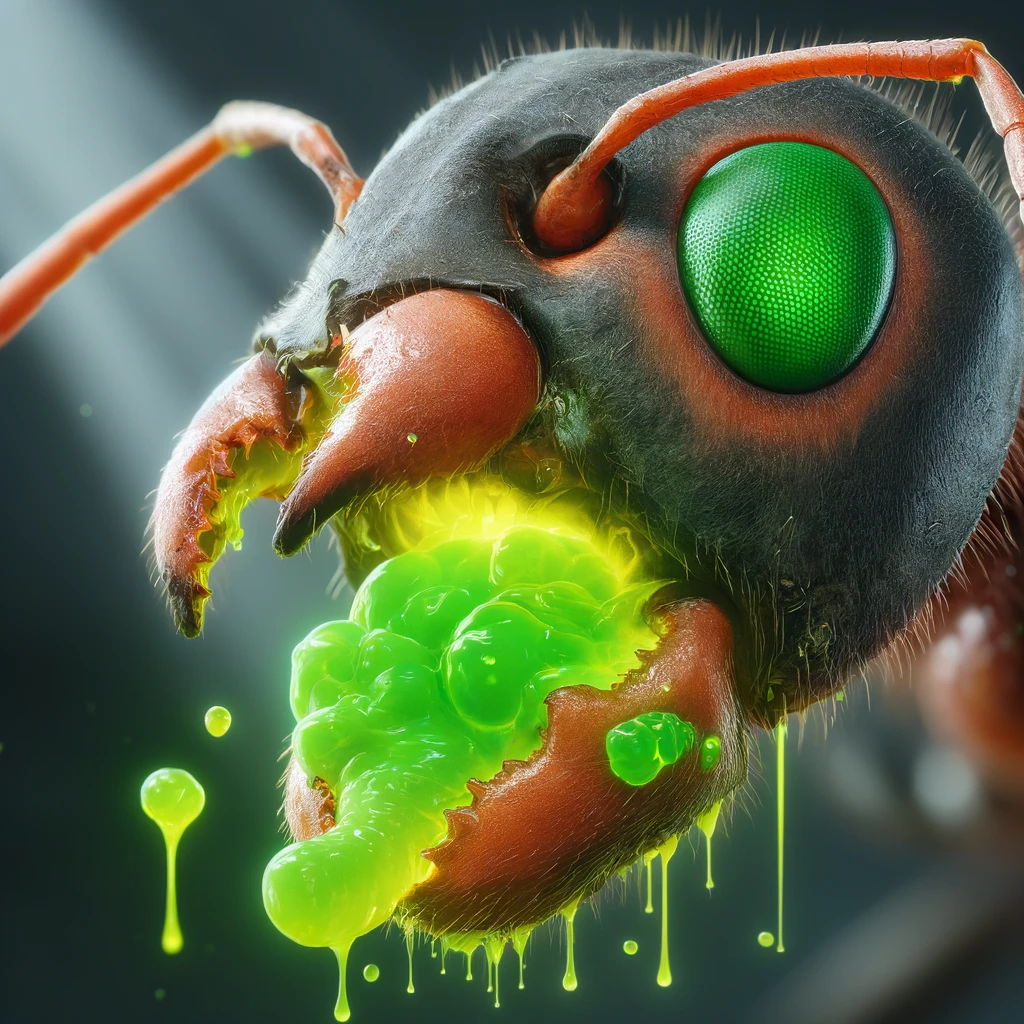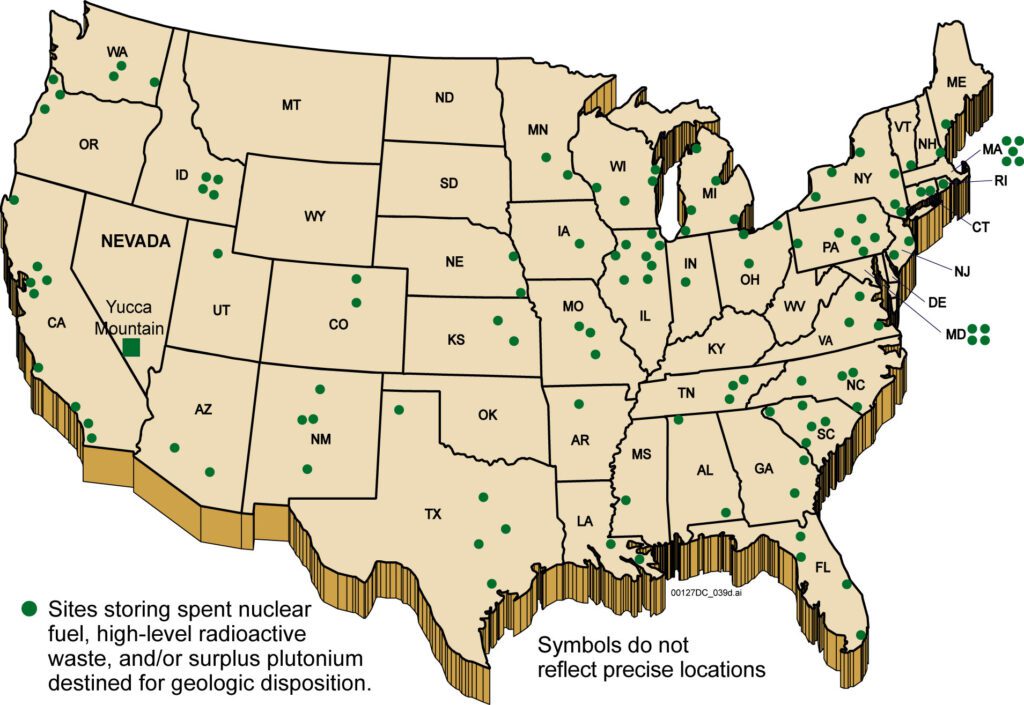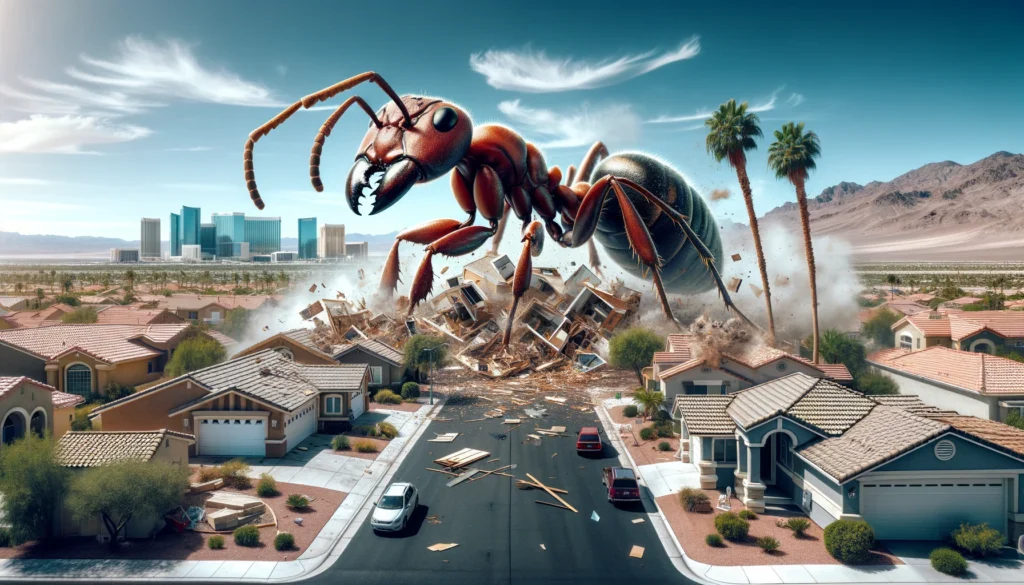
Giant Fire Ants | Radioactive Mutations Run Amok
Giant fire ants try to avoid humanity, but when humans act irresponsibly, these monsters come out of their burrows to wreck cities and military bases. Get the monstrous scoop after the jump.
Latest News from Monster Bureau
Giant Fire Ant Anatomy & Physical Characteristics

Overall, giant fire ants have a similar anatomy and physiology to the standard fire ant (Solenopsis xyloni). Each ant has:
- Abdomen
- Thorax
- Head
- Exoskeleton
However, giant fire ants show differences from their non-mutated relatives as described below.
Abdomen

No Stinger
Scientists aren’t sure why giant fire ants never developed stingers. Autopsies of females (only females have stingers) have shown those physiological features are present within its abdomen. It’s unclear why the stinger never grew like the standard fire ant.
Theories suggest radiation or its rapid growth rate stopped stinger and venom development. More tests are needed to find a cause.
Head
Acidic Goo On Mandibles

Unlike the standard fire ant, giant fire ants developed sacks inside their heads at the mandible. This oozes a radioactive, acidic green goo. It can dissolve cars within minutes, and human flesh melts on contact.
Field research suggests the ants use the goo as a defense mechanism as a bite will harm most predators, including soldiers in tanks, and deter attacks.
Giant fire ants have also developed the ability to squirt goo from a gland above the mandibles. One stream can reach as far as a half mile, and it can reach squirting speeds over 500 miles per hour.
Enhanced Vision
Standard fire ants can only see in light and dark. That’s not the case with giant fire ants, which appear to have compound eyes. These ocular structures allow them to see in nearly 360 degrees, notice the slightest movements, and precisely shoot their acidic goo. The common house fly has similar eyes and vision.
Thorax

Durability
The thorax and exoskeleton have proven resilient to heavy-weapons fire, land mines, tank shells and grenades. In most cases, a jet-propelled rocket is required to damage the giant fire ant’s exoskeleton. Once open, radioactive goo streams out, and that causes the ant to fall. However, the goo is intensely radioactive and kills with the slightest contact.
No Wings
Field researchers have not found any giant fire ants with wings. Standard fire ants, when sexually mature, develop wings. It’s understandable because ant wings wouldn’t lift an ant this large and heavy. Giant fire ants routinely weigh more than 3 tons, far more than physics would allow.
Radioactivity & Mutagenesis

Giant fire ants are made, not born. In most cases, scientists have traced them back to collected pools of toxic waste and/or radioactive pools. Fire ants stumble into the pools and mutagenesis begins. However, not every ant becomes a monster. There appears to be a genetic marker (M57) that unlocks rapid growth. It’s found in less than 1% of ants.
It may take 3 months or more for a standard ant to grow, shed its exoskeleton multiple times, and reach its new height (roughly 30 meters tall and 50 meters long).
Right now, it’s unclear how long a giant fire ant will live, but most scientists believe it’s less than 2 years.
Social Life & Isolation

In all cases, a giant fire ant developed from the worker class of ants. Unfortunately, once mutagenesis begins, the ant must leave the nest since its radioactivity will kill the other ants.
Scientists have found giant burrows near attack sites, which indicates something frightened or threatened the ant to attack the cause.
In rare cases, like the 1977 Tuscon case, two giant fire ants surfaced to destroy a shopping mall, but this is the only known group attack. It appears giant fire ants mutate, live and die alone.
Giant Fire Ant Habitat

While fire ants are a common insect found between the Carolinas and California, most encounters with giant fire ants happen in the desert southwest of the USA.
This is most likely related to the placement of nuclear and toxic waste sites in Arizona, New Mexico, Nevada and Utah. These are perfect locations with dense rock to contain the toxins and low population densities.
In most cases, giant fire ants formed after a toxic spill surfaced and formed a pool. There have also been instances where illegal drum dumping washed ashore and mutated ants into larger sizes. However, none of those ants have reached the size of the giant fire ant.
Feeding Habits & Prey

Humans, in general, have nothing to fear from giant fire ants. Research has shown that these giants avoid eating humans. For one, they aren’t large enough to satiate this monster. Their acidic goo tends to dissolve humans on contact, so a giant fire ant couldn’t eat a person in time.
The typical diet of a giant fire ant includes:
- Desert megaworms
- Giant spiders
- Giant lizards
- Large fields of crops like corn
It’s interesting to note that giant fire ants grow larger than many forms of other giant insects and reptiles.
Encroachments with Humanity

Giant fire ants do not seek to attack cities and suburbs. They usually attack when threatened. The rise in encounters is correlated to increased oil drilling and fracking in the Southwest. As humankind sinks new wells or begins fracking, they inadvertently destroy burrows and lairs. That activity draws out these monsters to defend their homes, leading to deadly encounters.
How to Protect Yourself from Giant Fire Ant Attacks

Protecting yourself against a giant fire ant destroying a city involves general disaster preparedness steps. Here’s what you could do:
Stay Informed
Always keep a way to receive emergency alerts, such as a NOAA weather radio, smartphone alerts, or local news channels. Understanding the nature of the threat is crucial to respond effectively.
Emergency Kit
Prepare an emergency kit that includes basic supplies, such as water, non-perishable food, first aid materials, flashlights, batteries, and other essentials you might need for at least 72 hours. Given the unique nature of the threat, including protective clothing and face masks might be advisable to protect against radioactive goo.
Evacuation Plan
Know your local evacuation routes, and have a clear plan in place for where to go if you need to leave your home quickly. Make sure every family member understands the plan.
Secure Your Home
For a giant fire ant, ensuring physical barriers are intact could help, such as reinforced windows or secured entry points.
Communication Plan
Have a way to communicate with your family or roommates during an emergency. Establish a meeting point in case you are separated and cannot access your devices.
Follow Authorities’ Instructions
Pay attention to instructions from local or national authorities. They will provide the most accurate and timely information regarding any ongoing threats or required actions.
Community Resources
Know what resources are available in your community. Local emergency services, community centers, and relief organizations might have specific plans or shelters that can offer assistance.
Sources:
While this article is fictional, the best fiction springs from factual information. Here are the websites and books I used to write this monster profile.
“Fire Ant Anatomy: Physiology & Characteristics of Fire Ants – Orkin.” Orkin, www.orkin.com/pests/ants/fire-ants/fire-ant-anatomy.
Hoffman, Dennis R. “Fire Ant Bites – StatPearls – NCBI Bookshelf.” National Center for Biotechnology Information, U.S. National Library of Medicine, 2023, www.ncbi.nlm.nih.gov/books/NBK470576/.
Image from: Choi, Man Bock, et al. “Traditional Labor-Intensive Methods for Collection of Fire Ant Venom.” Research Gate, 2016, www.researchgate.net/figure/Traditional-labor-intensive-methods-for-collection-of-fi-re-ant-venom-a-Many-studies_fig2_281239776.
Touchard, Axel, et al. “The Allergic Response Mediated by Fire Ant Venom Proteins.” Nature, vol. 561, no. 7724, 2018, pp. 512–516, www.nature.com/articles/s41598-018-32327-z.
Yang, Chih-Chun, et al. “Haemolytic Uremic Syndrome Following Fire Ant Bites.” BMC Nephrology, vol. 15, no. 1, 2014, pp. 1–6, bmcnephrol.biomedcentral.com/articles/10.1186/1471-2369-15-5.
“Fire Ant.” Wikipedia, Wikimedia Foundation, 31 Mar. 2024, en.wikipedia.org/wiki/Fire_ant. Accessed 13 May 2024.
“Arizona and fracking – Global Energy Monitor.” GEM.wiki, Global Energy Monitor, 14 July 2021, www.gem.wiki/Arizona_and_fracking.
“Fracking in Arizona.” Ballotpedia, ballotpedia.org/Fracking_in_Arizona. Accessed 14 May 2024.
Osborne, Hart. “In Southwest Texas, the Fracking Industry Encroaches on Small Towns, Remote Wilderness, and Clear Skies.” Desmog, 23 Nov. 2018, www.desmog.com/2018/11/23/southwest-texas-permian-fracking-alpine-balmorhea-big-bend/.
Groom, Nunez. “A Fracking Boom Ransacks the Four Corners.” NRDC, 20 Mar. 2019, www.nrdc.org/stories/fracking-boom-ransacks-four-corners.
Discover more from Ghosts & Monsters
Subscribe to get the latest posts sent to your email.